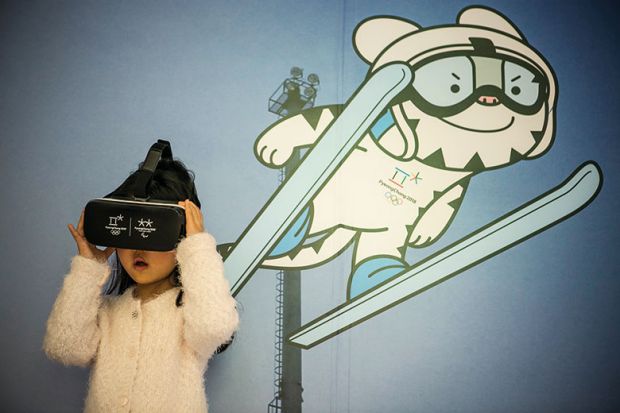The use of virtual reality technology in teaching does not improve learning outcomes, but students overwhelmingly favour the tool over more traditional methods, a study has found.
Researchers at Cornell University assessed students’ understanding of moon phases – as a ready example of a traditional physical teaching practice – via a multiple-choice test taken before and after an activity. A third of the students participated in a traditional hands-on method involving a ball on a stick; another third used a computer simulation; and the final group used an immersive virtual reality simulator.
The results showed that there was “no significant difference” between the teaching methods: the average score before the test was about 36 per cent, and that increased to about 58 per cent post-test in all three approaches.
However, students’ attitudes towards the methods were vastly different. After completing their activity, each participant was shown the other two methods, and the virtual reality mode was preferred by 78 per cent of participants.
Overall, 172 Cornell undergraduates participated in the study, “Virtual Reality as a Teaching Tool for Moon Phases and Beyond”, which was published in Physics Education Research Conference Proceedings.
Natasha Holmes, the Ann S. Bowers assistant professor of physics at Cornell and co-author of the study, said that one explanation for the similar learning outcomes could be that learning is driven more by the general activity than by the technology used, noting that the students were “doing really similar things” in all three methods.
Another potential reason is that the benefits or qualities that “we think simulations and virtual reality should have get balanced by the technical difficulties or the distracting details in virtual reality”, she added.
While an overwhelming majority of students preferred learning in the virtual reality mode, those who did not prefer it reported that they found it “overwhelming” or that they “didn’t know how to use the controllers”, Dr Holmes said, which suggests that virtual reality may have a greater impact once students are more familiar with the technology.
“We can either say the learning was no different so we should go with the cheaper option, or we could say…the students really enjoyed it and…that’s going to be a benefit if we can still produce learning that’s as good,” she said.
However, Dr Holmes said, it was important to carry out more research to determine whether students’ enjoyment of virtual reality might “wear off over time”.
Sam Smidt, director of the UCL Arena Centre for Research-based Education and an expert in technology-enhanced learning, said that the fact that “students appear to have a strong preference towards VR doesn’t in itself show that it’s worth using, although it is an encouraging finding”.
“This is a particular example, reproducing a well-established approach to teaching a concept in a new environment, and we should not be too surprised that the learning was not significantly different,” she added.
“Where we at UCL have argued for wider engagement with VR is in exploring its potential to teach in ways, or explore concepts, that are not easily delivered in the face-to-face or computer simulation environment. One recent example is the development of a VR environment in which GPs can interact with VR characters of abused children and their parents in a realistic, immersive way and practise these sensitive interactions.”
Register to continue
Why register?
- Registration is free and only takes a moment
- Once registered, you can read 3 articles a month
- Sign up for our newsletter
Subscribe
Or subscribe for unlimited access to:
- Unlimited access to news, views, insights & reviews
- Digital editions
- Digital access to THE’s university and college rankings analysis
Already registered or a current subscriber?








